AP-2 complex subunit mu is a protein that in humans is encoded by the AP2M1 gene. [5]
AP-2 complex subunit mu is a protein that in humans is encoded by the AP2M1 gene. [5]
This gene encodes a subunit of the heterotetrameric coat assembly protein complex 2 (AP2), which belongs to the adaptor complexes medium subunits family. The encoded protein is required for the activity of a vacuolar ATPase, which is responsible for proton pumping occurring in the acidification of endosomes and lysosomes. The encoded protein may also play an important role in regulating the intracellular trafficking and function of CTLA-4 protein. Two transcript variants encoding different isoforms have been found for this gene. [6]
AP2M1 has been shown to interact with CTLA-4 [7] [8] and Alpha-1B adrenergic receptor. [9]
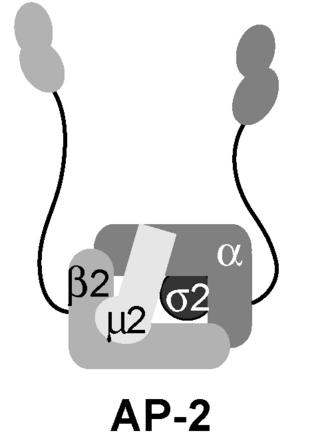
The AP2 adaptor complex is a multimeric protein that works on the cell membrane to internalize cargo in clathrin-mediated endocytosis. It is a stable complex of four adaptins which give rise to a structure that has a core domain and two appendage domains attached to the core domain by polypeptide linkers. These appendage domains are sometimes called 'ears'. The core domain binds to the membrane and to cargo destined for internalisation. The alpha and beta appendage domains bind to accessory proteins and to clathrin. Their interactions allow the temporal and spatial regulation of the assembly of clathrin-coated vesicles and their endocytosis.

AP-2 complex subunit alpha-1 is a protein that in humans is encoded by the AP2A1 gene.

AP-1 complex subunit mu-1 is a protein that in humans is encoded by the AP1M1 gene.

AP-1 complex subunit gamma-1 is a protein that in humans is encoded by the AP1G1 gene.

Clathrin heavy chain 1 is a protein that in humans is encoded by the CLTC gene.

AP-2 complex subunit alpha-2 is a protein that in humans is encoded by the AP2A2 gene.
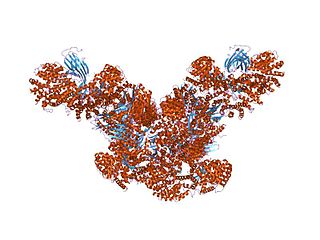
AP-1 complex subunit beta-1 is a protein that in humans is encoded by the AP1B1 gene.

AP-2 complex subunit beta is a protein that in humans is encoded by the AP2B1 gene.

AP-1 complex subunit mu-2 is a protein that in humans is encoded by the AP1M2 gene.

AP-1 complex subunit sigma-1A is a protein that in humans is encoded by the AP1S1 gene.

Sorting nexin-9 is a protein that in humans is encoded by the SNX9 gene.
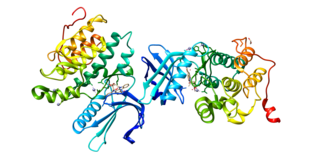
Adaptor-associated protein kinase 1 also known as AP2-associated protein kinase 1 is an enzyme that in humans is encoded by the AAK1 gene and is involved in clathrin mediated endocytosis. Alternatively spliced transcript variants have been described, but their biological validity has not been determined.

AP-1 complex subunit gamma-like 2 is a protein that in humans is encoded by the AP1G2 gene.

AP-3 complex subunit mu-1 is a protein that in humans is encoded by the AP3M1 gene.
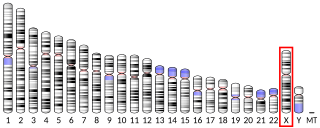
AP-1 complex subunit sigma-2 is a protein that in humans is encoded by the AP1S2 gene.

Epsin-1 is a protein that in humans is encoded by the EPN1 gene.

AP-2 complex subunit sigma is a protein that in humans is encoded by the AP2S1 gene.

AP-3 complex subunit sigma-1 is a protein that in humans is encoded by the AP3S1 gene.
Clathrin adaptor proteins, also known as adaptins, are vesicular transport adaptor proteins associated with clathrin. These proteins are synthesized in the ribosomes, processed in the endoplasmic reticulum and transported from the Golgi apparatus to the trans-Golgi network, and from there via small carrier vesicles to their final destination compartment. The association between adaptins and clathrin are important for vesicular cargo selection and transporting. Clathrin coats contain both clathrin and adaptor complexes that link clathrin to receptors in coated vesicles. Clathrin-associated protein complexes are believed to interact with the cytoplasmic tails of membrane proteins, leading to their selection and concentration. Therefore, adaptor proteins are responsible for the recruitment of cargo molecules into a growing clathrin-coated pits. The two major types of clathrin adaptor complexes are the heterotetrameric vesicular transport adaptor proteins (AP1-5), and the monomeric GGA adaptors. Adaptins are distantly related to the other main type of vesicular transport proteins, the coatomer subunits, sharing between 16% and 26% of their amino acid sequence.
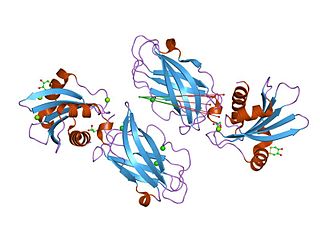
The C-terminal domain ofBeta2-adaptin is a protein domain is involved in cell trafficking by aiding import and export of substances in and out of the cell.